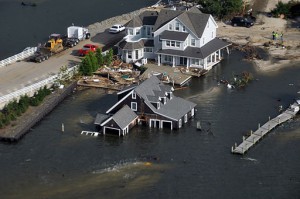New Jersey Future Blog
State Hazard Mitigation Plan Should Do More To Address Risk, Integrate With Local Planning
April 11th, 2014 by Chris Sturm
 New Jersey Future today joined with six local and national planning and environmental advocacy organizations in submitting formal comments on the Draft 2014 State of New Jersey Hazard Mitigation Plan (HMP). The letter calls on the New Jersey Office of Emergency Management (NJOEM) to amend the plan to ensure that it addresses vulnerability and future risk adequately, and to modify the plan to ensure that state agencies, county and local governments develop effective mitigation strategies to guide development and infrastructure investments so that vulnerability to impacts of future storms is reduced.
New Jersey Future today joined with six local and national planning and environmental advocacy organizations in submitting formal comments on the Draft 2014 State of New Jersey Hazard Mitigation Plan (HMP). The letter calls on the New Jersey Office of Emergency Management (NJOEM) to amend the plan to ensure that it addresses vulnerability and future risk adequately, and to modify the plan to ensure that state agencies, county and local governments develop effective mitigation strategies to guide development and infrastructure investments so that vulnerability to impacts of future storms is reduced.
Signing the comment letter in addition to New Jersey Future were the New Jersey Chapter of the American Planning Association; American Littoral Society; NY/NJ Baykeeper; the National Resources Defense Council; PlanSmart NJ and Clean Ocean Action.
“This is a key opportunity to apply the lessons from Superstorm Sandy in helping all levels of government become better prepared for future storms,” said Chris Sturm, New Jersey Future’s senior director of state policy. “Hazard mitigation strategies should be incorporated into everything communities do to plan for their future, and right now the draft plan offers neither the guidance nor the structure to enable that to happen.”
“We can no longer assume that the past is an accurate predictor of future natural disasters,” said Rob Moore, senior policy analyst at the Natural Resources Defense Council. “Because of climate change we know the frequency and severity of floods, droughts, and extreme weather is going to be very different in the future. States need to factor that into their disaster preparedness plans and their strategies for dealing with these risks.”
“Both the product and the process are important if this effort is to make a difference,” said Bob Kull, co-chairman of the Hazard Mitigation and Recovery Planning Committee of the New Jersey chapter of the American Planning Association, and one of the authors of the state’s original Hazard Mitigation Plan. “It involves more than the emergency management community. It involves more than the first responders. It involves the people that shape land use and infrastructure going forward. Local planning boards, developers and the legal community are all stakeholders in the outcome.”
“Municipalities and counties are looking to the state for guidance on how to respond to the effects of climate change,” said Stacy McCormack, director of government relations at American Littoral Society. “Unfortunately, the state’s Hazard Mitigation Plan does not provide enough direction.”
Because the plan was submitted to FEMA on March 5, 2014, six days prior to the opening of the 30-day public comment period on March 11, the letter also asked that the state request that FEMA delay a final determination with respect to the plan, so that comments submitted during the designated comment period have an actual and realistic probability of influencing the plan and to allow NJOEM the opportunity to review and incorporate the comments into the HMP.
The groups offered several recommendations for modifications that would achieve these objectives, including:
- Replacing the current processes for scoring mitigation projects with an objective, criteria-based, transparent methodology immune from political influence, including quantifying risk reduction and a robust analysis of costs and benefits. Proposed modifications to the plan are intended to help the state to allocate technical assistance and financial resources more effectively based on transparent and objective standards.
- Provide the guidance and technical assistance municipalities and counties need so they may adopt effective local plans in an efficient and affordable manner. Recommendations stressed the importance of encouraging and, where possible, requiring, tight integration among the state HMP and local master plans, land use and zoning regulation and capital investments so that all short- and long-term actions coalesce to reduce risk and vulnerability.
- Integrate acknowledged future risks from rising sea levels and climate change into decision-making about land use plans and regulations and mitigation project prioritization. The recommendations underscored the obligation the state has to address sea level rise effectively and aggressively, and the central role it must play in assisting local governments, particularly those along the coast, to plan for and, where possible, mitigate this risk.
The full comments are available here.

















Good job – but in scanning your comments, surprised that you support the locally driven assessment of risk and the over-relaince on local and county management.
The State’s role needs to be enhanced and NJ can no longer rely on effectively delegating this program to local governments.
Locals don’t have the incentives, resources, or capacity to do this work.
Additionally, the State, especially DEP, can do a LOT more in regulatory policy.
But State leadership has been derailed by Gov. Christie’s Executive Order # 4, which, under the guise of the “no unfounded state mandate” slogan has gutted and State policy and regulation.
One of the biggest threats to New Jersey is virtually never mentioned, which is that the background level of highly toxic tropospheric ozone has surpassed a level that is tolerable to vegetation. Damage to longer-lived species, such as trees, is cumulative, and leads first to shrunken roots, injured foliage and worst of all, a increased vulnerability to biotic attacks. Opportunistic lethal infestations of insects, fungus and disease now occur as massive epidemics.
This is a global issue that is particularly pronounced in our state, which has truly epic concentrations of ozone. New Jersey should lead the way in demanding a drastic reduction in emissions of nitrous oxides, the precursors to ozone formation.
Dying trees lead directly to increases in wildfires, and falling branches cause loss of life, property, and power lines. Much of the economic cost of Sandy was directly attributable to trees that fell because they were rotting inside.
See links to hundreds of published research papers and books here: http://scienceblogs.com/gregladen/2013/01/29/whispers-from-the-ghosting-trees/